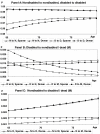Improving knowledge about disability transitions by adding retrospective information to panel surveys. Population health metrics
- PMID: 17166277
- PMCID: PMC1716181
- DOI: 10.1186/1478-7954-4-16
Improving knowledge about disability transitions by adding retrospective information to panel surveys. Population health metrics
Abstract
Background: Panel data are often used to estimate key measures of public health, such as years lived with and without disability. Panel surveys commonly measure disability at intervals of one or two years, and occasionally more than two. It is likely that these intervals often include unreported changes in functional status. Unreported changes may bias estimates of disability transition probabilities, which are commonly used to estimate years lived with and without disability. Most surveys do not ask participants about periods with and without disability in the time since they last responded to the survey. We examined a way to improve the usefulness of panel surveys and our understanding of disability processes, by eliciting retrospective disability information.
Methods: Data were from the United States' National Long Term Care Survey. At each wave, this survey asks disabled respondents how long they have been disabled. We tested whether estimates of probabilities predicting changes in disability status can be improved by making use of this retrospective disability information. Methods included embedded Markov Chain analysis, microsimulation, and the Hausman specification test.
Results: Estimates based on data that include retrospective information are significantly different from those that use only the more limited information that is contemporaneous to the surveys. They are also more efficient. At age 65, all estimated probabilities for becoming disabled were higher when retrospective information was used, and all probabilities for remaining disabled were lower. Microsimulation revealed that using retrospective information increased the number of functional status transitions. For example, for women the mean number of transitions from nondisabled to disabled or dead was 52.7% greater when retrospective information was added to the analysis.
Conclusion: Our results suggest that the value of future panel studies for estimating transitions in disability could be notably enhanced by adding a small number of questions asking respondents for details about their disabilities--and lack of disabilities--in the period since a preceding survey wave. Information provided by such questions could substantially improve both the measurement of disability histories and estimates of disability processes.
Figures
Similar articles
-
Modeling transition rates using panel current-status data: how serious is the bias?Demography. 2009 May;46(2):371-86. doi: 10.1353/dem.0.0057. Demography. 2009. PMID: 21305398 Free PMC article.
-
Disability in two health care systems: access, quality, satisfaction, and physician contacts among working-age Canadians and Americans with disabilities.Disabil Health J. 2008 Oct;1(4):196-208. doi: 10.1016/j.dhjo.2008.07.006. Disabil Health J. 2008. PMID: 21122730
-
[Old and new long stay patients in French psychiatric institutions: results from a national random survey with two-year follow-up].Encephale. 2005 Jul-Aug;31(4 Pt 1):466-76. doi: 10.1016/s0013-7006(05)82408-x. Encephale. 2005. PMID: 16389714 French.
-
Mental health, social functioning, and disability in postwar Afghanistan.JAMA. 2004 Aug 4;292(5):575-84. doi: 10.1001/jama.292.5.575. JAMA. 2004. PMID: 15292083
-
Treatment disparities for disabled medicare beneficiaries with stage I non-small cell lung cancer.Arch Phys Med Rehabil. 2008 Apr;89(4):595-601. doi: 10.1016/j.apmr.2007.09.042. Arch Phys Med Rehabil. 2008. PMID: 18373987 Review.
Cited by
-
More Education May Limit Disability and Extend Life For People With Cognitive Impairment.Am J Alzheimers Dis Other Demen. 2014 Aug;29(5):436-47. doi: 10.1177/1533317513518648. Epub 2014 Jan 9. Am J Alzheimers Dis Other Demen. 2014. PMID: 24413536 Free PMC article.
-
Modeling transition rates using panel current-status data: how serious is the bias?Demography. 2009 May;46(2):371-86. doi: 10.1353/dem.0.0057. Demography. 2009. PMID: 21305398 Free PMC article.
References
-
- Branch LG, Ku L. Transition probabilities to dependency, institutionalization, and death among the elderly over a decade. J Aging Health. 1989;3:370–408.
-
- Manton KG, Corder LS, Stallard E. Estimates of change in chronic disability and institutional incidence and prevalence rates in the U.S. elderly population from the 1984, and 1989 National Long Term Care Survey. J Geron Soc Sci. 1982;48:S153–166. - PubMed
-
- Manton KG, Land KC. Active life expectancy estimates for the U.S. elderly population: a multidimensional continuous-mixture model of functional change applied to completed cohorts, 1982–1996. Demography. 2000;37:253–265. - PubMed
LinkOut - more resources
Full Text Sources


